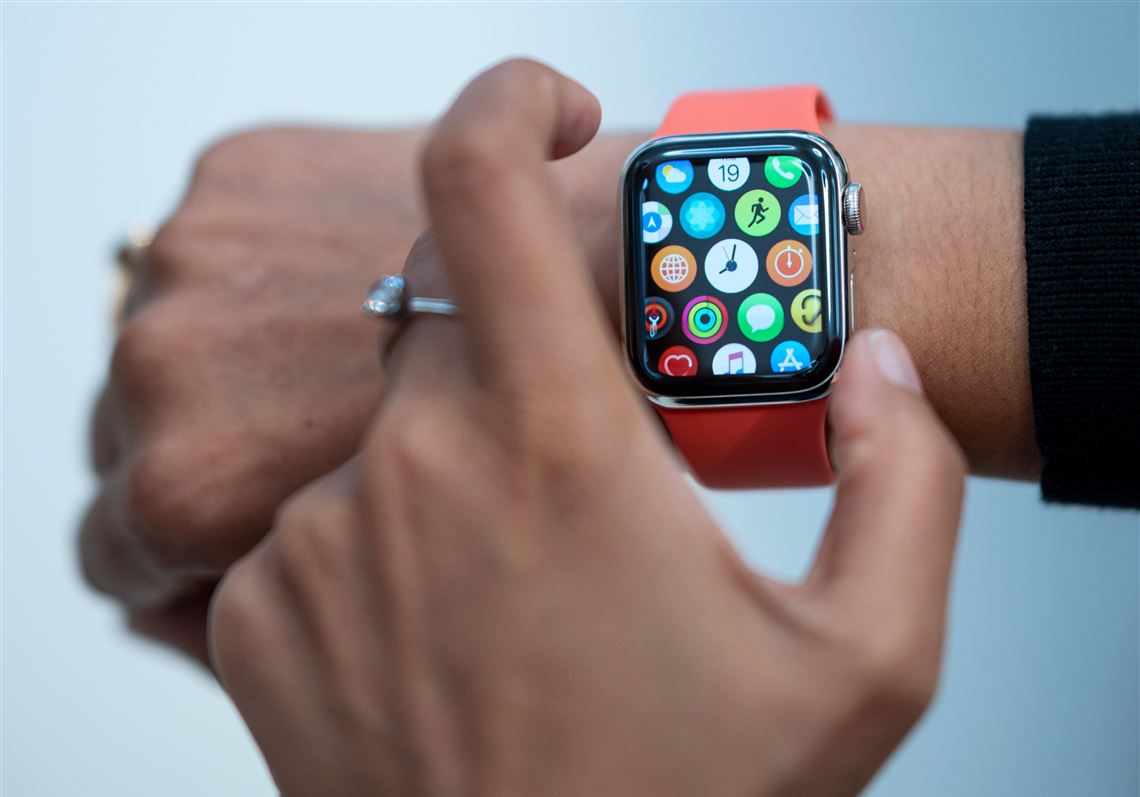When the COVID-19 pandemic hit the region and Gov. Tom Wolf ordered all non-emergency medical care to shut down in March, the impact on the interaction between patients, technology and health care was immediate.
“We went from less than 5% of visits being telehealth pre-COVID to almost 100% between March and May,” Dr. Srinivas Murali, a cardiologist and director of Allegheny Health Network’s Cardiovascular Institute, said of the health network’s cardiology patients.
While the rise in telehealth visits — where patients talk to their doctors on a computer screen, or at least over the phone, versus an in-person visit — has been well known, a related phenomenon was a massive increase in the use of remote patient monitoring devices, particularly for cardiology patients who need regular checks of their heart’s vital signs.
With recommendations from their doctors that they buy them, cardiology patients began bringing home devices in droves that measure blood pressure and heart rates, even ECG — electrocardiogram — devices that can do a more detailed evaluation of a heart’s rhythms, some for as little as $40, but many costing $100 or $200, and even more sophisticated versions that cost more than $1,000.
The devices, many of them wireless and portable, come now from dozens of companies like Omron, Infobionic and Alivecor and have found their way onto kitchen and side tables all over the country, and, with wearable devices, including the new Apple Watch that can perform an ECG, onto patients’ arms.
They are being used at home with patients recovering from heart attacks, strokes or congestive heart failure, to those at-risk with arrhythmia, high blood pressure and other issues.
Dr. Indu Poornima, director of AHN’s Section of Preventive Cardiology and board president of the American Heart Association of Greater Pittsburgh, said less than 30% of her patients before COVID-19 had any kind of remote monitoring device. But since March, more than 50% now have at least one such device.
“It has more than doubled among my patients,” she said. “It has been amazing how quickly we adapted to that, and how quickly patients were accepting of that.”
Such massive growth “is a sea change,” Dr. Murali said.
“The pandemic has forced us to really transform and look at remote monitoring in a different context,” he said. “For this to grow more, reimbursement is the key element.”
Like telehealth itself prior to March, insurance is the main stumbling block to even further use of remote devices that have been shown to benefit health.
The reason telehealth use exploded was not just because patients were so determined to see their doctors. After the COVID-19 pandemic was declared in March, the federal Centers for Medicare & Medicaid Services suddenly approved telehealth visits for reimbursement — after resisting that for more than a decade — and all the private insurers followed.
“Without [CMS’s approval of telehealth coverage] we would not be able to provide most services” during the pandemic, said Dr. Heba Wassif, a cardiologist at Cleveland Clinic and a member of the American College of Cardiologists Care Innovation Council. “So what I’m seeing with what CMS has done is that they showed they were embracing digital health before this. But they were only taking baby steps.”
Dr. James Adisey, a cardiologist at Excela Health, which has three hospitals in Westmoreland County, said it looks as if eventually CMS will have to approve reimbursing remote patient devices, much in the same way that they eventually approved telehealth.
As with telehealth, he said: “Once we can show CMS and other insurance carriers that they have become part of our guidelines, that they enhance care, they’ll start to cover them.”
Part of his optimism, he said, is that “I think once we come out of this [pandemic] the whole country’s health care is going to be transformed. It’s going to force us in a good way to transform how we take care of people.”
Many of his colleagues in the field agree that CMS’s approval of telehealth bodes well for the eventual approval of reimbursement for remote devices — particularly since leaving them accessible only to those with the money to buy them makes no sense.
“We’re optimistic that we’ll get reimbursement [from insurance] eventually,” said Dr. Sahil Parikh, a member of the American College of Cardiologists vascular disease council and an interventional cardiologist at Columbia University’s Irving Medical Center. “With one fell swoop we were already able to get all the insurance companies and CMS to reimburse us for telehealth visits” early in the pandemic.
But, for now, “too many of these remote monitors remain inaccessible physically and financially for some of our patients,” he said. “Remote testing sounds great. But if we can’t bring them to the populations that need them the most, that [health] gap [between demographic groups] will only widen.”
The American Heart Association feels so strongly about the role that remote blood pressure monitoring can play in improving health and preventing serious cardiac events that it has been donating blood pressure monitors to federally qualified health centers on the country in hopes of getting them to those who can’t afford them.
And the heart association regularly highlights the American Medical Association’s list of AMA-vetted home blood pressure monitors as a way to encourage people to use them.
Dr. Monique Reese, senior vice president of home and community care for Highmark Health, the parent company to AHN, oversees Highmark’s Home Recovery Program that is being piloted in three AHN hospitals - Allegheny General, Forbes and Jefferson.
It allows qualified patients in certain health categories to be sent home earlier with conditions that could be managed - including heart failure - to recover, rather than recover in the hospital.
The program includes sending a nurse to the patient’s home to help set up remote monitoring devices in the home - including blood pressure and pulse oximeters using Bluetooth technology to transmit data, and even a remote stethoscope to listen to the heart and lungs with a nurse assisting. In addition to nurses, therapists and nurses aides can be sent to the home to help the patient.
So far, a dozen patients have been approved to be included in the program, and that will increase as more hospitals are added to the program.
“It’s high tech and high touch,” Dr. Reese said. “The use of technology, remote patient monitoring and virtual visits, are all imperative to this program’s success.”
Dr. Poornima notes that “preventive cardiology is based on numbers and data and adjusting medication and care based on those numbers and data.”
During a pandemic, in-home monitoring becomes less of an added feature to care than “invaluable replacement” of the kind of testing that typically is done in a hospital or doctor’s office, she said.
“Every time I do a televisit now, vitals are such an important part of our physical exam,” she said. “Now, before the visit, my nurse calls and asks the patient if they have a home blood pressure monitor and if they have any data available we can look at.”
For example, she said, blood pressure and ECG monitoring can help keep watch over hypertension, which is a risk factor for atrial fibrillation (sometimes known as AFib), which is a form of arrhythmia that can lead to stroke, heart failure and other heart-related complications.
Dr. Bill Belden, a clinical cardiac electrophysiologist at Allegheny General Hospital, who works with patients with heart arrhythmia issues, said that since March he has seen “a grand total of two patients in person” because of the desire to keep patients at home.
And much of what he does with his exams — ECGs — can now be accomplished by remote monitoring devices, he said.
“These electronic recording devices are fantastic,” he said. “I just need a tracing of their heart rhythms. They can do it at home and email it to me.”
He now regularly talks to patients in places as distant from his North Side office as Altoona, looking over an ECG a patient recorded on their own and makes an assessment of how they are doing.
“Getting a tracing of their heart rhythm is 90 percent of what I need,” he said.
“I had one patient with an Apple Watch” set up to watch her heart rate, he said. “It notified her that her heart rate had jumped to 140 [beats per minute] and she sent me a tracing and it was right.”
The home monitoring devices that do an ECG are still “not equivalent to a hospital EKG,” he said. “But they’re quite efficient.”
A lot of patients now have the Apple Watch that can both monitor heart rates and even do an ECG, he said.
“And there was a concern that we were going to be buried under with the ‘My-watch-said-this-what-does-it-mean?’ patients. But it hasn’t happened yet. It still may.”
“There’s going to come a day when we send patients home with these devices,” he said. “Though I don’t think any insurance companies will be reimbursing people to buy an Apple Watch anytime soon.”
Unfortunately, he said, “I know of no insurance payments for any of these.”
Stuart Long, CEO of Infobionic, which makes one of the most widely used remote patient monitoring devices called the MoMe Kardia device to monitor ECG data for heart patients at home.
His device, however, is used for diagnostic tests ordered by their cardiologists, and the test — even though it’s conducted at home — is reimbursable by insurance.
But Mr. Long said one advancement that he hopes to see for nondiagnostic devices is when products like a Fitbit, which easily monitors heart rates, could be synced to work with approved medical devices to provide that data.
“It would be nice to be able to connect a Fitbit to a MoMe device. We’re working toward that,” he said. “But it’s hard to take a non-FDA [Food and Drug Administration] compliant system [like Fitbit] and connect it to an approved medical device.”
At some point, he said he can see where people are able to go to the local pharmacy and “buy a box of 20 patches that you stick on your arm to monitor your vital signs. But we’re a ways away from that.”
Dr. Colin Movsowitz, a cardiologist in Norriton, outside Philadelphia, uses the MoMe device for many of his patients, and looks forward to the day when even nondiagnostic tools are better at providing the kind of real-time information he can get from MoMe.
“We are going to have to advocate to get” insurance reimbursement for such devices, he said.
“But we also need better information to continue to do telehealth visits,” he said. “I know a lot of physicians who love doing the telehealth visits, but people are missing things in those visits.”
“It’s not all roses with telehealth. It comes with significant shortcomings,” he said. “And if we’re going to continue to do them, we need appropriate monitoring of the patients.”
Sean D. Hamill: shamill@post-gazette.com or 412-263-2579 or Twitter: @SeanDHamill.
First Published: August 7, 2020, 9:18 a.m.



















